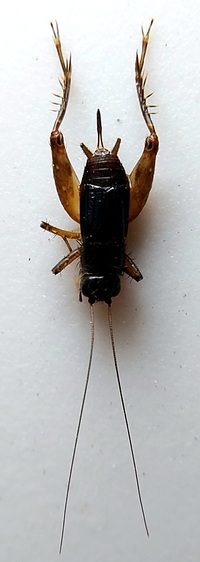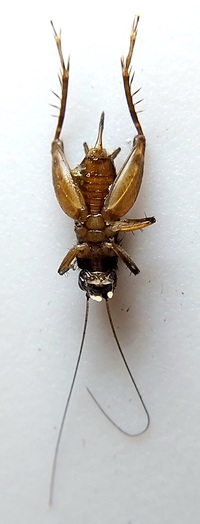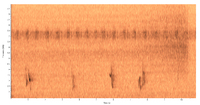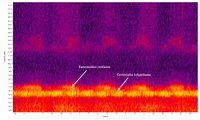Family (Alpha): ACRIDIDAE GRYLLACRIDIDAE GRYLLIDAE GRYLLOTALPIDAE RHAPHIDOPHORIDAE ROMALEIDAE TETRIGIDAE TETTIGONIIDAE TRIDACTYLIDAE
View Gryllidae Members:
Acheta domesticus Anurogryllus arboreus Gryllus unidentified species Gryllus firmus Gryllus fultoni Gryllus pennsylvanicus Gryllus pennsylvanicus/veletis Gryllus pennsylvanicus-veletis Gryllus rubens Gryllus veletis Miogryllus verticalis Velarifictorus micado Hapithus agitator Orocharis unidentified species Orocharis luteolira Orocharis saltator Cycloptilum unidentified species Cycloptilum bidens Cycloptilum pigrum Cycloptilum slossoni Cycloptilum tardum Cycloptilum trigonipalpum Cycloptilum velox Myrmecophilus pergandei Allonemobius allardi Allonemobius fultoni Allonemobius griseus griseus Allonemobius griseus funeralis Allonemobius maculatus Allonemobius socius Allonemobius sparsalsus Allonemobius tinnulus Allonemobius walkeri Allonemobius unidentified species Eunemobius carolinus Eunemobius confusus Eunemobius melodius Eunemobius unidentified species Neonemobius cubensis Neonemobius palustris Neonemobius variegatus Pictonemobius ambitiosus complex Pictonemobius ambitiosus Pictonemobius hubbelli Nemobiinae unidentified species Oecanthus unidentified species Oecanthus celerinictus Oecanthus exclamationis Oecanthus fultoni Oecanthus latipennis Oecanthus nigricornis Oecanthus niveus Oecanthus pini Oecanthus quadripunctatus Neoxabea bipunctata Phyllopalpus pulchellus Anaxipha delicatula Anaxipha exigua Anaxipha litarena Anaxipha rosamacula Anaxipha thomasi Anaxipha tinnula Anaxipha tinnulacita Anaxipha tinnulenta Anaxipha vernalis Anaxipha new species near vernalis Anaxipha unidentified species Cyrtoxipha columbiana Falcicula hebardi Gryllidae unidentified species NC Records
Eunemobius confusus (Blatchley, 1903) - Confused Ground Cricket
Taxonomy
Family: Gryllidae
Subfamily: NemobiinaeTribe: PteronemobiiniSynonym: Nemobius confusus Comments: One of three species in this genus that occur in North America north of Mexico (Cigliano et al., 2017), all three of which have been recorded in North Carolina
Identification
Field Guide Descriptions: Elliot and Hershberger (2006) Online Photographs: SINA, Songs of Insects, Google Images ,
iNaturalist , GBIF Technical Description, Adults/Nymphs: Hebard (1913)SINA 538a.htm Comments: A glossy, pitch black ground cricket. The head, thorax, and tegmina are shiny blackish-brown, with the legs somewhat lighter brown. The bone-white palps of both sexes are highly characteristic (Hebard, 1913). Eunemobius carolinus also has pale, but not bone-white palps, and can also be distinguished from confusus by the much lighter, yellowish-brown color of its head and thorax.Total Length [body plus wings; excludes ovipositor]: 6.4, males; 6.7, females (Hebard, 1913)Structural Features: Members of Eunemobius can be distinguished from Allonemobius and Neonemobius by their possession of equal length ventral spurs on the hind tibiae and by ovipositors that have serrulations on the ventral margin of the tip (smooth in the other genera) and coarse teeth on the dorsal margin (finely serrulate in the other genera) (Hebard, 1913; SINA, 2017). Hebard (1913) stated that the hindwings are absent in this species. Fulton (1931) also did not include confusus in the group of species with macropterous forms.Singing Behavior: Fulton (1931) described the song of confusus as a "droning, buzzy trill like the song of carolinus", but with a consistent division into two (sometimes three) weak pulses, followed by a longer one that rises in volume followed by pause. Each of these trills are given at a rate of one to two per second at 70 F. A song presented on SINA has a dominant pitch of 6.9 kHz.Recording playback at normal speed.
Download Video:
"MP4"
Distribution in North Carolina
County Map: Clicking on a county returns the records for the species in that county.
Adult Dates: Click on graph to enlarge
Habitats and Life History
Habitats: In his description of the species, Blatchely (1903) mentioned that it was common in "low damp woods bordering Tippicanoe Lake". (Brimley (1908) also described the habitat of confusus as "damp places, not far from water". On the other hand, Fulton (1931) described it as less of a bottomland and mesic forest species than Allonemobius maculatus, and that it appeared, instead, to prefer hardwood forests growing on well-drained slopes and uplands. Our records agree with Fulton, coming almost entirely from well-drained slopes, mostly mesic but some dry. Diet: Probably omnivorousObservation Methods: Most easily detected by its song.Abundance/Frequency: Fulton (1931) described this species as "never very abundant", although we have heard it calling in fairly good numbers at many sites in the Piedmont.Adult Phenology: Fulton (1931) noted that adults of confusus have been found near Raleigh as early as July 29. Brimley (1908) reported finding it in the same area from mid-August to late November.
Status in North Carolina
Natural Heritage Program Status: Natural Heritage Program Ranks: [GNR] S3S5State Protection: Has no legal protection, although permits are required to collect it on state parks and other public landsComments: We currently have too few records for this species to be sure of its status in North Carolina. While it seems likely to occur in hardwood forests across at least the Piedmont and low mountains, if it is actually a flightless species, the effects of habitat fragmentation need to be determined.
Image Gallery for Eunemobius confusus - Confused Ground Cricket Recorded by: Steve Hall and David George Recorded by: Steve Hall Recorded by: Steve Hall Recorded by: Steve Hall Recorded by: Mark Basinger Recorded by: Mark Basinger Recorded by: Steve Hall Recorded by: Jim Petranka Recorded by: Stephen Hall Recorded by: Jim Petranka Petranka and Becky Elkin Recorded by: Jim Petranka Recorded by: Steve Hall Recorded by: Stephen Hall Recorded by: Steve Hall
MP3 Gallery for Eunemobius confusus - Confused Ground Cricket 1
Your browser does not support the audio element.
Recorded by: Steve Hall 2
Your browser does not support the audio element.
Recorded by: Jim Petranka 3
Your browser does not support the audio element.
Recorded by: Jim Petranka Petranka and Becky Elkin 4
Your browser does not support the audio element.
Recorded by: Jim Petranka
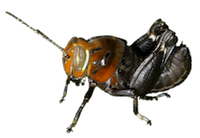
 »
»





